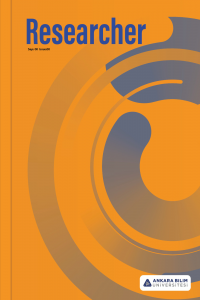Dönemler Arası Fayda Maksimizasyonu Çerçevesinde Tüketim Faiz İlişkisi: Ramsey-Kopmans-Keynes Modeli
Ramsey-Kopmans-Keynes Modeli, Dönemlerarası Tüketim, Para Politikası
Consumption in Periods of Utility Maximization Between Sectors Interest Relationship: Ramsey-Kopmans-Keynes Model
___
- Afondi, A. (2005). Monetary policy transmission mechanism and structural breaks in Indonesia. University of Wollongong Thesis Collection, http://ro.uow.edu.au/cgi/viewcontent.cgi?filename=0&article=1640&context=theses&type %.. (27.06.2018).
- Akyüz, Y. (2017). Kriz, Marx ve Keynes Bölüşüm, Finansallaşma ve Ekonomik Durgunluk. İktisat ve Toplum, Sayı:74.
- Auclert, A. (2017). Monetary Policy and Redistribution Cahnnel. NBER Working Papers, w23451, http://www.nber.org/papers/w23451.pdf (22.06.2018).
- Blanchard, O. J. Ve Fisher, S. (2000). Lectures on Macroeoconomics. England: The MIT Press.
- Böhm-Bawerk, E. (1890). Capital and Interest. New York: Macmillan Co. https://misesedia.s3.amazonaws.com/Capital%20and%20Interest.pdf?file=1&type=document (12.06.2018).
- Brunhoff, S ve Duncan K. F. (2006). Karl Marx’s Theory of Money and Capital. (Ed.) Phillip Arestis and Amlcom Sawer (Ed.). Handbook of Alternative Monetary Economics, UK Edward Elgar Publishing.
- Clarida, R. H., Gali, J. ve Mark, G. (2001). Optımal Monetary Polıcy In Closed Versus Open Economıes: An Integrated Approach. Nber Working Paper, No: 8604.
- Cushing, M. J. (1999). “The indeterminacy of prices under interest rate pegging: The nonRicardian case. Journal Of Monetary Economics, 44:131-148.
- Dladla Pholile, Christopher Malikane, Kalu Ojah. (2014), “The Elasticity of Intertemporal Substitution Reconsidered”, MPRA Paper No. 55547, https://mpra.ub.unimuenchen.de/55547/1/MPRA_paper_55547.pdf, (10.07.2018).
- Engel, C. (2015). Exchange Rates, Interest Rates, And The Risk Premium. Nber Working Paper Series, Working Paper no. 21042.
- Frankel, J. (2014). Nominal GDP Targeting for Middle Income Countries. Central Bank Review, 14, pp1-14.
- Giovannini, A. ve Labadie, P. (1991). Asset Prices and Interest Rates in Cash-in-Advance Models. Journal of Political Economy, 99(6 ):1215-1251.
- Hyman, P. M. (2013). İstikrarsız Bir Ekonominin İstikrarı” Çev: Oğuz Esen, Ankara Efil Yayınevi
- Mitra, T. ve Sorger, G (2013). Ramsey’s Conjecture. Journal of Economic Theory, 148: 1953- 1976.
- Mohanty, M. S. ve Klau, M. (2004). Monetary policy rules in emerging market economies: issues and evidence. BIS Working Papers, No: 149.
- Phelps, E. S. (1968). Money-Wage Dynamics and Labor Market Equilibrium. Journal of Political Economy, 76,(4): 678-711.
- Ravn, M., Grohe, S.S. ve Uribe, Martin. (2012). Consumption, Goverment Spending and Real Exchange Rate. Journal of Monetary Economics, 59:215-234.
- Romer, D. (2012). Advanced Macroeconomics, USA: McGraw-Hill Irwin, Fourth Edition. Süslü, B.ve Yılmaz, E. (2015). The Relation between Money, Interest and Consumption in Developing Countries: The Case of Turkey. Journal of Economics and Development Studies, 3(3):155-164.
- Süslü. B. ve Baydur, C.M. (2002). Para İkamesi ve Türkiye’deki Gelişimi. İstanbul Üniversitesi Siyasal Bilgiler Fakültesi Dergisi, 27:93-106.
- Tang, J. (2014). Uncertainty and the Signaling Channel of Monetary Policy. Federal Reserve Bank of Boston.
- Thimme, J. (2017). Intertemporal Substitution in Consumption: A Literature Review. Journal of Economic Surveys, 31(1): 226-257.
- Woodford, M. (2003). Interest and Prices: Foundation of a Theory of Monetary Policy. USA: Princeteon University Press.
- ISSN: 2717-9494
- Yayın Aralığı: Yılda 2 Sayı
- Başlangıç: 2013
- Yayıncı: Ankara Bilim Üniversitesi
Geçmişten Günümüze İran’da Kadın Ruh Sağlığını Etkileyen Faktörler
Samineh ESMAEİLZADEH, Mualla YILMAZ
Ortaokul Öğrencilerinin Kitap Seçimine Yön Veren Etmenler
Emine ÖZDEMİR ÇIRAKMAN, Bülent ARI
Sosyal Bilgiler Dersinde Sosyobilimsel Bir Konu Olarak Küresel Isınma Hakkında Öğrenci Görüşleri
Sefa GEDİK, Çağrı ÖZTÜRK DEMİRBAŞ
Non Toksik Metal Gravür Uygulamalarında Kullanılan Fotopolimer Film Solar Plaka Uygulamaları
Müge KANTAR DAVRAN, Mehmet Reşit SEVİNÇ, Burhan ÖZALP, Gönül SEVİNÇ
Eğitsel Oyun ve Drama Tekniklerinin Bilgisayar Donanımları Konusundaki Akademik Başarıya Etkisi
Mehmet Can ŞAHİN, Nihan ARSLAN NAMLI
Veysî’nin “Hâb-Nâme”si ve Namık Kemal’in “Rüya”sında Konu, Devir ve Üslup
Postmodern Sanatın Kamusal Alanlara Yansıyan Kavramsal İzleri: Micheal Rakowitz
